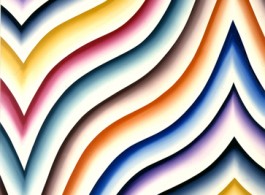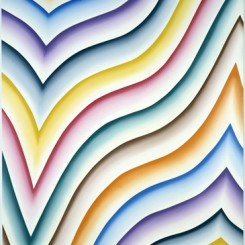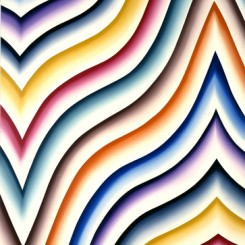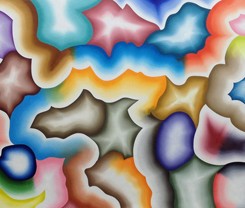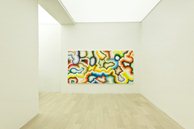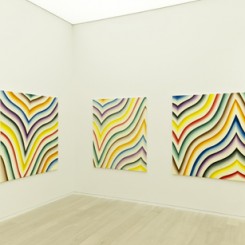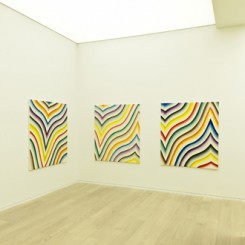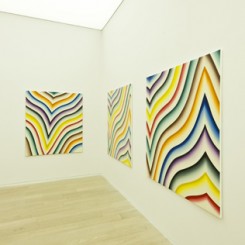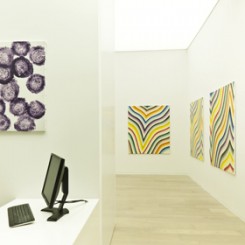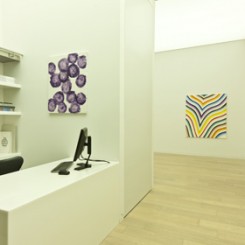Simon Lee Gallery Hong Kong is pleased to announce an exhibition of paintings by Bernard Frize.
With a career which spans more than 40 years, Bernard Frize is widely recognised as one of the most important and influential painters of his time. The breadth of the formal and conceptual vocabulary he has developed, encompassing elements of process, of seriality, of colour and of the passage of time has made the influence of his work on painters of his own and later generations unsurpassed.
Frize’s abstract compositions are the systematic products of carefully constructed sets of rules, sometimes elaborate, sometimes simple; choreographed performances which determine the works’ formal compositions.
For his first exhibition in Hong Kong, Frize will show paintings from the 2004 sequence Insulaire alongside one new monumental work. Of the Insulaire paintings Frize has written:
The starting point is a motif composed of eight colours, from which I cut 27 different frames. The edges were covered with tape, and then the colours were painted on four at a time. I chose this motif for its potentialities, because it suggests all kinds of images: the strata of a geological section, a landscape, a fan, an Indian fabric, a rainbow. But I do not care much about these suggestions. Paradoxically, the ambiguous nature of the motif creates the effect of the image disintegrating, allowing me to replace it with a visual and mental mechanism.
Placed end to end, the canvasses follow one another in precise arrangement. A continuous band constructs a panorama around the spectator, and each painting in it is a viewpoint. The whole thing begins to vibrate, but this phenomenon is slowed down by disruptions: here a fault in the canvas, by attracting the eye to the materiality of the painting, cancels out its decorative aspect; there the change in intensity of a gradation of colour has the effect of arresting the circular motion. Defects and disruptions vie with one another to bring the dynamics of fragmentation back into play: they cast the mind back to elements of the construction of the whole. (Bernard Frize, FAT Paintings, exhibition catalogue, Kunsthalle Brandts. October 7 2007 – January 20 2008)
This idea of fragments of a whole has a particular resonance when considering the disjunction between Frize’s studio practice and the structure of display of his work. While the bodies of work he develops in series are often worked through in the studio in their entirety in the way he describes here, when he shows the works, he will often place works from different series together, pulling them out from the company of their siblings and highlighting resonances between paintings which result from quite different systems of making.
The result is to underline the artist’s own assertion that all his paintings are in a certain sense, one and the same, each the result of the application of this systematic approach. The rules may be different, but the project is the same.
Taken out of the context of the complete series each painting acts as a microcosm of the whole, carrying within it all the associations and resonances of the system and method of the series. It is for this reason that the dialogues between the works from different series Frize presents are so vibrant. Here, Plontois, a 3.6 metre frieze-like painting from 2012 is juxtaposed with the Insulaire works. It too uses a modelled gradation of paint within each band of colour to suggest volume, a formal device which gave its name to the 2007 exhibition of the Insulaire sequence at Kunsthalle Brandts: “Bernard Frize FAT Paintings”. In this new work, though, the riotous swirling ebullience of colour seems to rupture any logical ordering in the picture plane, creating a tension between the system of the Insulaire paintings and the freedom of the new work.
Bernard Frize was born in 1949 in Saint Mandé, France. He lives and works between Paris and Berlin. His work is represented in public collections around the world, including: The Tate Gallery, London; Centre Pompidou, Paris; MUMOK, Vienna; NMAO the National Museum of Art Osaka, Museo Nacional Centro de Reina Sofia, Madrid; Museum of Contemporary Art, Los Angeles; Museum fur Moderne Kunst, Frankfurt the Kunstmuseum, Basel and the Kunstmuseum, Zurich.
He has exhibited extensively both in Europe and in the United States including solo exhibitions at Musée d’Art Moderne de la Ville de Paris, France; Berlinische Galerie, Berlin; Museum Morsbroich, Leverkusen; Museum Gegenstandsfreier Kunst Landkreis, Cuxhaven; Westfälisches Landesmuseum für Kunst und Kulturgeschichte, Germany; Gemeente Museum, La Haye, and de Pont, Tilburg, Holland; S.M.A.K., Gent, Belgium; Kunstmuseum St. Gallen; Kunstmuseum Basel, Switzerland; The Bakersfield Museum of Art and The Carnegie Museum of Art, Pittsburgh, USA; and Kunsthalle Brandts, Odense, Denmark. He participated in the 2012 Bienal of Sao Paulo, curated by Luis Perez-Oromas.

